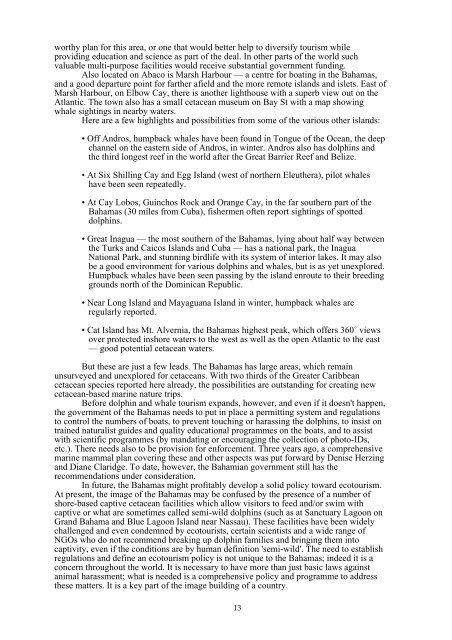The Potential of Whale Watching in the Caribbean: 1999+
The Potential of Whale Watching in the Caribbean: 1999+
The Potential of Whale Watching in the Caribbean: 1999+
You also want an ePaper? Increase the reach of your titles
YUMPU automatically turns print PDFs into web optimized ePapers that Google loves.
worthy plan for this area, or one that would better help to diversify tourism while<br />
provid<strong>in</strong>g education and science as part <strong>of</strong> <strong>the</strong> deal. In o<strong>the</strong>r parts <strong>of</strong> <strong>the</strong> world such<br />
valuable multi-purpose facilities would receive substantial government fund<strong>in</strong>g.<br />
Also located on Abaco is Marsh Harbour — a centre for boat<strong>in</strong>g <strong>in</strong> <strong>the</strong> Bahamas,<br />
and a good departure po<strong>in</strong>t for far<strong>the</strong>r afield and <strong>the</strong> more remote islands and islets. East <strong>of</strong><br />
Marsh Harbour, on Elbow Cay, <strong>the</strong>re is ano<strong>the</strong>r lighthouse with a superb view out on <strong>the</strong><br />
Atlantic. <strong>The</strong> town also has a small cetacean museum on Bay St with a map show<strong>in</strong>g<br />
whale sight<strong>in</strong>gs <strong>in</strong> nearby waters.<br />
Here are a few highlights and possibilities from some <strong>of</strong> <strong>the</strong> various o<strong>the</strong>r islands:<br />
• Off Andros, humpback whales have been found <strong>in</strong> Tongue <strong>of</strong> <strong>the</strong> Ocean, <strong>the</strong> deep<br />
channel on <strong>the</strong> eastern side <strong>of</strong> Andros, <strong>in</strong> w<strong>in</strong>ter. Andros also has dolph<strong>in</strong>s and<br />
<strong>the</strong> third longest reef <strong>in</strong> <strong>the</strong> world after <strong>the</strong> Great Barrier Reef and Belize.<br />
• At Six Shill<strong>in</strong>g Cay and Egg Island (west <strong>of</strong> nor<strong>the</strong>rn Eleu<strong>the</strong>ra), pilot whales<br />
have been seen repeatedly.<br />
• At Cay Lobos, Gu<strong>in</strong>chos Rock and Orange Cay, <strong>in</strong> <strong>the</strong> far sou<strong>the</strong>rn part <strong>of</strong> <strong>the</strong><br />
Bahamas (30 miles from Cuba), fishermen <strong>of</strong>ten report sight<strong>in</strong>gs <strong>of</strong> spotted<br />
dolph<strong>in</strong>s.<br />
• Great Inagua — <strong>the</strong> most sou<strong>the</strong>rn <strong>of</strong> <strong>the</strong> Bahamas, ly<strong>in</strong>g about half way between<br />
<strong>the</strong> Turks and Caicos Islands and Cuba — has a national park, <strong>the</strong> Inagua<br />
National Park, and stunn<strong>in</strong>g birdlife with its system <strong>of</strong> <strong>in</strong>terior lakes. It may also<br />
be a good environment for various dolph<strong>in</strong>s and whales, but is as yet unexplored.<br />
Humpback whales have been seen pass<strong>in</strong>g by <strong>the</strong> island enroute to <strong>the</strong>ir breed<strong>in</strong>g<br />
grounds north <strong>of</strong> <strong>the</strong> Dom<strong>in</strong>ican Republic.<br />
• Near Long Island and Mayaguana Island <strong>in</strong> w<strong>in</strong>ter, humpback whales are<br />
regularly reported.<br />
• Cat Island has Mt. Alvernia, <strong>the</strong> Bahamas highest peak, which <strong>of</strong>fers 360˚ views<br />
over protected <strong>in</strong>shore waters to <strong>the</strong> west as well as <strong>the</strong> open Atlantic to <strong>the</strong> east<br />
— good potential cetacean waters.<br />
But <strong>the</strong>se are just a few leads. <strong>The</strong> Bahamas has large areas, which rema<strong>in</strong><br />
unsurveyed and unexplored for cetaceans. With two thirds <strong>of</strong> <strong>the</strong> Greater <strong>Caribbean</strong><br />
cetacean species reported here already, <strong>the</strong> possibilities are outstand<strong>in</strong>g for creat<strong>in</strong>g new<br />
cetacean-based mar<strong>in</strong>e nature trips.<br />
Before dolph<strong>in</strong> and whale tourism expands, however, and even if it doesn't happen,<br />
<strong>the</strong> government <strong>of</strong> <strong>the</strong> Bahamas needs to put <strong>in</strong> place a permitt<strong>in</strong>g system and regulations<br />
to control <strong>the</strong> numbers <strong>of</strong> boats, to prevent touch<strong>in</strong>g or harass<strong>in</strong>g <strong>the</strong> dolph<strong>in</strong>s, to <strong>in</strong>sist on<br />
tra<strong>in</strong>ed naturalist guides and quality educational programmes on <strong>the</strong> boats, and to assist<br />
with scientific programmes (by mandat<strong>in</strong>g or encourag<strong>in</strong>g <strong>the</strong> collection <strong>of</strong> photo-IDs,<br />
etc.). <strong>The</strong>re needs also to be provision for enforcement. Three years ago, a comprehensive<br />
mar<strong>in</strong>e mammal plan cover<strong>in</strong>g <strong>the</strong>se and o<strong>the</strong>r aspects was put forward by Denise Herz<strong>in</strong>g<br />
and Diane Claridge. To date, however, <strong>the</strong> Bahamian government still has <strong>the</strong><br />
recommendations under consideration.<br />
In future, <strong>the</strong> Bahamas might pr<strong>of</strong>itably develop a solid policy toward ecotourism.<br />
At present, <strong>the</strong> image <strong>of</strong> <strong>the</strong> Bahamas may be confused by <strong>the</strong> presence <strong>of</strong> a number <strong>of</strong><br />
shore-based captive cetacean facilities which allow visitors to feed and/or swim with<br />
captive or what are sometimes called semi-wild dolph<strong>in</strong>s (such as at Sanctuary Lagoon on<br />
Grand Bahama and Blue Lagoon Island near Nassau). <strong>The</strong>se facilities have been widely<br />
challenged and even condemned by ecotourists, certa<strong>in</strong> scientists and a wide range <strong>of</strong><br />
NGOs who do not recommend break<strong>in</strong>g up dolph<strong>in</strong> families and br<strong>in</strong>g<strong>in</strong>g <strong>the</strong>m <strong>in</strong>to<br />
captivity, even if <strong>the</strong> conditions are by human def<strong>in</strong>ition 'semi-wild'. <strong>The</strong> need to establish<br />
regulations and def<strong>in</strong>e an ecotourism policy is not unique to <strong>the</strong> Bahamas; <strong>in</strong>deed it is a<br />
concern throughout <strong>the</strong> world. It is necessary to have more than just basic laws aga<strong>in</strong>st<br />
animal harassment; what is needed is a comprehensive policy and programme to address<br />
<strong>the</strong>se matters. It is a key part <strong>of</strong> <strong>the</strong> image build<strong>in</strong>g <strong>of</strong> a country.<br />
13
















